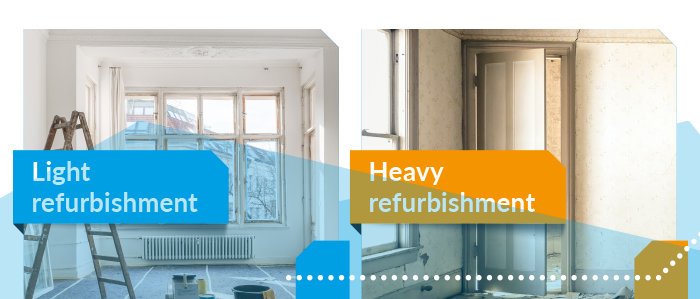A Complete Guide
- 24-page overview of refurbishment finance
- Refurb planning, costs & tax relief
- Different finance types & lending criteria
- Finance calculator & case studies
Get your free Refurbishment Finance Guide below.

Property refurbishment finance
The only guide you’ll ever need
Refurbishment finance, and the general improvement of properties, can cover a broad range of outcomes. Property refurbishment finance can be used for everything from basic cosmetic changes, through to the substantial remodelling of a home.
Given this breadth, this guide will break down everything investors need to know about renovation finance into digestible chunks. We will explore how and why investors could get involved with refurbishment plans, how to finance property refurbishment, the strategies and options available, and more.
We will also provide insight on what’s going on in the market, along with examples of how we’ve delivered refurbishment finance for investors.

Refurbishment vs. renovation vs. refurnishing
People may use the terms refurbishment, renovation, and refurnishing interchangeably. Often, this may be suitable enough. But there can be key differences between what the terms entail that investors should be aware of.
To start with, refurbishment tends to involve the upgrading of features with new (hopefully better) materials or versions. Common examples can include installing a new kitchen, or redesigning a garden.
Renovations usually refers to restoring a space to be in good working, liveable conditions. An old building with a decrepit roof will likely need renovating, as opposed to refurbishment.
Refurnishing, on the other hand, involves getting entirely new furniture to replace what came before. A homeowner can simply get rid of their old couches and purchase new ones to spruce up the space.
There are also conversion plans. These involve the changing of a property type to accommodate a new market. An office block can be converted into residential flats, for example.
What’s important to note is that all these options can fall under the “refurbishment finance” umbrella.

3 Reasons to refurbish
There are many reasons why a homeowner or property investor would want to refurbish a property. Some of these reasons may be born out of necessity. Landlords, for example, must keep their properties up to certain standards for their tenants.
- Their properties must tick specific health and safety boxes. Should owners fall foul of these minimums, for whatever reason, they’ll need to upgrade their properties as soon as possible to get them up to scratch.
- Property investors may also seek to refurbish their properties in an effort to raise their values. Modernising a home, for instance, could make it more desirable for tenants or potential buyers.
- Refurbishment can also make properties more energy efficient. This may not only lead to happier renters or buyers who may be willing to pay a bit more for a greener space, but could also lower ongoing costs for homeowners.

How to plan a refurbishment
Refurbishment works will likely vary from person to person. As such, there isn’t a single template or checklist that would be applicable for all. A landlord aiming to install new kitchen tiles will have very different priorities to an investor planning a major conversion project.
But, there are a few basic elements that could be incorporated into any refurbishment project.
The options
From the outset, investors should map out their options. They should have a clear understanding of what changes are possible, and how individual tasks should be organised.
The schedule
From here, they could then focus on timeframes – exploring how long the project will take, and when they could expect a return on their investment. Once a realistic schedule is at least outlined, they could then think about how to finance the property refurbishment. Will they require specialist finance in the short-term, and how will they secure long-term funding?
Generally, for house renovations, it can take several weeks to complete the most common projects. This includes kitchen renovations, bathroom renovations, loft conversions, and extensions. What’s more, each of these projects can cost several thousands of pounds to complete.
The paperwork & costs
To minimise the chances of things going wrong, investors could carry out a property survey to get a baseline understanding of the state of the property, and find out if planning permission will be needed for their plans. From here, they could then seek the expertise of, and get initial quotes from designers, architects, builders, and others to get the ball rolling. These professionals will be able to provide estimations of the costs involved and will allow investors to decide whether they want to manage the project themselves, or utilise a project manager.
A schedule of works should be created, and then tradespeople can be hired to get the work underway. There are many trade bodies and websites that can help find the right people for the job at hand. This includes the Federation of Master Builders, the Association of Plumbing & Heating Contractors, or even Checkatrade.com.

Top 10 home improvements
Preferences for home improvement plans will also vary greatly. Nevertheless, certain upgrades tend to be especially popular among the UK population. The top 10 home improvements made among homeowners between 2017 and 2020, according to Statista, were:
- A new bathroom (38% of respondents)
- New kitchen (34%)
- New central heating boiler (34%)
- Replacing windows (29%)
- Landscaping (27%)
- Roof repair/new roof (21%)
- New heating (15%)
- New heating insulation (12%)
- Adding or replacing driveway (11%)
- Adding/renovating outbuildings (9%)
Specifically, new kitchens, bathrooms, and double glazing proved popular among buyers and renters alike.
Going green has also been a priority for many in the property market in recent years, with eco-conscious upgrades potentially adding several thousand pounds to a home’s value. Some of the most value-adding green improvements include installing solar panels, triple-glazed windows, and cavity wall insulation. The improvement can potentially increase the value of the property and contribute to the ongoing annual energy bill savings, which can also stretch into the thousands.
If investors primarily focus on adding value to a home with refurbishments and/or renovations, a few key options tend to see the best results. Loft and basement conversions could add up to 20% to a property’s value, while incorporating an open-plan living space may add up to 15%. Meanwhile, in certain parts of London, creating a basement under a home may even double its value.
What’s important to remember though, is that all of this is contingent. The outcomes of any refurbishment plan will be dependent on an investor’s budget, costs, circumstances, and more. Any homeowner exploring their renovation financing options needs to make sure the actions they take are right for them, and their background.

Who can get refurbishment finance?
Refurbishment finance is broadly available to property investors of varying backgrounds, but each lender will have its own minimum requirements.
At Market Financial Solutions, our permitted & light development loans are generally available to property investors aged between 21 and 85. Individual property investors can apply for our property refurbishment finance, as can a business entity. Our funding can be utilised by the self-employed, LLPs, SPVs, trusts, and more.
Every one of our loans is assessed on its own merits. Meaning, the answer to who can get refurbishment finance will vary greatly – but are accessible to a very wide range of applicants with different circumstances. But, every single one of our cases is underwritten from day one, and every applicant will be guided through the process by a dedicated underwriter.
Lending criteria
Our refurbishment finance is available to many types of investors. On top of being open to individual borrowers and corporate entities, our refurb finance can be utilised by foreign nationals and offshore companies.
Everything from light refurbishment finance through to permitted development funding is available, so long as the capital is used for property based in England or Wales. We’re happy to consider applicants from any country, other than those that are sanctioned. We can also work with those who may have complications in their background, such as missed payments, bankruptcies, or CCJs.
We can also accommodate a number of repayment strategies. Serviced monthly, fully retained, and part retained & serviced monthly interest payment plans are available to our borrowers.
Investors who plan to use our refurbishment finance for green upgrades should be checking as to the current laws surrounding EPC ratings – especially the minimum needed to let a property, as this is the minimum Market Financial Solutions will require a property to hold if they are to lend.

What can refurbishment finance be used for?
Our refurbishment finance can be used for a broad range of properties. Residential properties include:
- Apartments
- HMOs such as student accommodation or shared flats
- Detached and semi-detached houses
- Terraced and end of terrace homes
- Cottages, bungalows, and more.
It’s also possible to improve commercial and semi-commercial properties with renovation financing. Our funding can be put to use for
- Offices
- Restaurants
- Shops and more.
Property refurbishment finance can be used for assets purchased in the open market, as well as those won at auction. Often, debilitated properties in need of a bit of TLC can turn up in auction houses.
Bidders may be able to purchase these properties at a discount, and use refurbishment finance to bring them back to life. This could be particularly useful for investors engaging with a fix-and-flip strategy. Refurb finance can also help those looking to change the use of a property – turning a storage hub into a hotel, for example.

Types of work for refurbishment finance
There are many different kinds of refurbishment projects but broadly, they can fall into two categories. There is light/permitted refurbishment, and “heavy” refurbishment.
Light refurbishment finance is available for building projects that do not need planning permission – aka “permitted development rights”. The changes investors can make to a property under permitted development rules can be tricky to understand, and so professional guidance should be sought before any undertaking.
However, broadly, certain extension projects, conversions, cosmetic changes, and upgrades can be completed without needing planning permission. A general rule is that developments and/or renovations should be in keeping with the local streetscape, and have no negative impact on immediate neighbours.
Heavy refurbishment is the kind that will likely need planning permission from a local planning authority (LPA). Planning permission will usually be required by those who want to build something new, make a major change to a building, or change the use of a building.
At Market Financial Solutions, we can provide refurbishment finance for heavy renovation work where planning permission has either been approved, or is not required at all. During the underwriting process, we’ll need information on the kind of works investors will be carrying out, along with how far into the process they are.
Regardless of whether our funding is being used for the remodelling of a living room, or converting an abandoned warehouse, we vow to deliver funding as quickly and as smoothly as possible. We can issue refurbishment finance in as little as three days to help investors pursue their projects with confidence.

Costs to refurbish a house
Refurbishment and/or renovation costs will be varied by several internal and external factors. The size of the project at hand, along with an investor’s circumstances will impact the ongoing costs. As too will the general economic environment, like inflation.
Given the variables involved, it can be difficult to identify average costs for refurbishment works. But, checkatrade.com keeps track of ballpark averages for different types of work and, as to be expected, smaller projects tend to cost much less than more substantial plans.
A new gas supply for an average 3-bed house, for example, may only set investors back around £500. Meanwhile, installing a new kitchen for the same house could easily cost £25,000.
Generally, if investors plan to completely overhaul a home, the average total renovation cost for a 3-bed house may cost anywhere between £77,000 – £139,000. On top of this, it’s wise to add a contingency fund of 10-15% of a budget for the unexpected. But, while the costs of upgrading a home could seem high initially, they may still be lower than the alternatives.
Homes in need of improvement can be priced competitively. Buying a “fixer-upper” home at a low price, and then spending money improving it, may still work out cheaper than investing in an immaculate property at a premium.
Being selective may also help lower costs. Investors may not need to go with the biggest changes to see results. More budget friendly options can still add value to a home.
For instance, cosmetic tweaks to a kitchen, such as changing its colour or switching up the lighting, can add thousands to a home’s price. There may not be a need to completely rip out a room and start over.
Tax relief for refurbishment costs
Landlords may be able to take advantage of certain allowable expenses when investing in a property. But, they need to be clear on what will be a qualifying expense. Generally, investors can deduct expenses from their rental income when they work out their taxable rental profit – so long as they are wholly and exclusively for the purposes of renting out the property.
Other types of expenses that could be deducted include money spent on general maintenance and repairs, and the costs of certain services – including the wages of gardeners and cleaners. When it comes to refurbishments, expenses cannot be claimed for improvements made that boost a property’s value – only those that repair existing issues.
Tax relief may also be available for commercial projects, such as office refurbishments. Capital allowance relief could also be utilised for conversions. The rules around tax relief are complex however, and so investors should seek out expert guidance to take advantage of what’s available.

Types of refurbishment finance
At Market Financial Solutions, our permitted & light development loans can be 1st or 2nd charge. Refurbishment finance can be used for renovations, conversions, and lighter projects.
Outside of bespoke bridging loans however, there are other financial products and means that investors can utilise. Those with enough spare capital to their name could use cash to fund their projects. This may limit costs and speed up the process.
Other forms of unsecured loans may also be of use. Credit cards could help with smaller plans, while some lenders may offer personal loans for home improvements. Although these options are often highly dependant on one’s credit rating/financial history.
Those who already own property assets could also engage with equity release and/or remortgaging. These options will allow homeowners to release capital from their properties which can then be put to use for a refurbishment.
What’s more, green mortgages are available to applicants looking to be greener with their purchases. While these products vary between lenders, it’s possible to find green mortgages that reward people for carrying out eco-conscious home improvements. Installing solar panels being a typical example. Lenders who offer these mortgages may offer applicants discounted interest rates, or cashback on money borrowed to improve a home’s efficiency.
As to be expected, there are many products and options available to investors looking to engage with a renovation project. It will be up to individual applicants and their financial or mortgage advisors to determine what option is right for their circumstances.
Fees involved
Refurbishment finance fees will vary between lenders. On top of the applicable rates involved, some lenders will add on additional fees which raise a borrower’s total costs. Property investors will need to be on top of whether they’ll need to pay certain legal fees, broker fees, admin fees, and more.
At Market Financial Solutions, as we underwrite from day 1, our fee structure is clear from the get-go. We have no admin fees, and commitment fees are refunded on draw-down. Our arrangement fees start from 1%.
Meanwhile, exit fees are applicable for our refurbishment loans, with the amounts determined at the point of application. From the start of an application with Market Financial Solutions, investors will have a dedicated underwriter, who will keep them up to speed on all the costs involved.
Useful tool: Refurbishment Finance Calculator
Our refurbishment finance calculator is a free, interactive tool that allows users to figure out the overall cost of taking out renovation finance. Investors can calculate how much they may be able to borrow for their project, what they’ll need to pay back, and determine if Market Financial Solutions can provide them with the refurb finance they need.
The calculator requires a few basic details from users. They’ll need to identify if they’re after 1st or 2nd charge refurbishment finance, enter a property value, and loan amount required.
They’ll also need to enter a term for their loan which, for renovation finance, will need to be between 3 and 18 months. Finally, the tool allows users to select an interest payment plan, and play around with potential interest rates and arrangement fees.
As these details are entered, results will be displayed and updated in real time.

How to apply for refurb funding
To apply for refurbishment finance, investors will need to send through an initial loan enquiry. This can be done via our website, over the phone, or through email. Once we receive an enquiry, an underwriter will respond within 4 hours.
This underwriter will be the enquirer’s designated contact throughout their loan journey.
To start with, our underwriter will issue indicative terms, subject to credit approval and receipt of specific information from the borrower. A decision in principle (DIP) will then be issued, subject to valuation, due diligence, and legal terms.
So long as everything is accounted for, and the investor is happy to progress, we will then get the valuation organised, collect commitment fees, and instruct the solicitors involved to move forward.
As we reach the final stages, legal paperwork will be issued, and the commitment fee is refunded. Finally, the loan is drawn down, and the borrower can put the capital towards their refurbishment project.

What information do I need to provide?
Every property refurbishment finance application is different, and no two cases ever look identical. Which is why every one of our borrowers has a dedicated underwriter to guide them through the process.
Generally though, those who make sure their application and accompanying documentation is up to scratch, and who are good communicators, will likely benefit from a smoother process. For refurbishments, we’ll likely need details on the type of work being planned.
Are you using the capital for cosmetic tweaks or structural tweaks? Knowing where the investor is regarding planning permission will also be helpful.
We will also need to understand the borrower’s end-goal. Are they planning to remodel a home to flip at a profit, or convert an empty office block in an attempt to target a new market? Having a schedule of works available will support the application.
What’s most important for us, is understanding the borrower’s exit strategy. We will not issue funding without a clear exit strategy available. But, there are many options available to investors here.
Investors can sell a property on to other buyers to cover their refurbishment finance, or refinance onto long-term options. While these are some of the more common choices, other options can also be utilised.
Other financial assets can be sold to cover the loan. A pension lump sum or inheritance may also suffice. It may also be possible to exit a refurbishment loan via one of our other bespoke products. Our borrowers could move onto development exit finance, or a BTL mortgage, so long as these options suit their circumstances.
Broadly, we’re happy to accept a range of options for an exit strategy, so long as it can be evidenced.

Why use Market Financial Solutions for refurbishment finance
As one of the UK’s prominent independent bridging finance providers, Market Financial Solutions provides a range of fast and flexible bridging loans and buy-to-let mortgages to all our intermediaries and clients. With nearly 20 years of experience behind us, we’re adept at tailoring all our specialist products to our borrowers in a prompt and professional manner.
We also have a range of resources and tools at our disposal to help our borrowers. Our calculators and educational materials allow investors to keep up with the market and make tactile, informed decisions. And with multiple institutional funding lines behind us, we’re able to comfortably support a range of refurbishment, renovation, and conversion strategies.
All our products are available to both private individuals and commercial borrowers. We understand that no two deals are ever the same and we’ll always go that extra mile to identify how we can best serve our clients.

Industry Insights
Turning a garage into an extra bedroom will add an average of £77,526 to a home’s value, leaving residents with an average profit of £59,526, according to GoCompare. (GoCompare)
The most recent government statistics, released in November 2023, showed there were 261,189 long-term empty properties in England. That figure represents a rise of 12,556 homes compared to 2022, up 5% annually and 16% since before the pandemic in 2019. (Big Issue)
Global office leasing volumes are around 6% lower than a year ago, and 24% lower than pre-pandemic levels. This is prompting owners and investors to consider turning offices into other types of real estate, from housing to hotels. (JLL)
Office-to-residential repurposing, for example, can be a solution to acute housing shortages; the 250 million square feet of vacant office space in the top 35 European cities could provide 500,000 homes. (JLL)
Case study 1
A borrower turned to us to help them with refurbishment plans for a property that would eventually be used for a BTL investment. The underwriter on this case had to deal with a few issues in the client’s background that threatened to slow down the deal.
Fortunately, by embracing teamwork and forward planning, we were able to move forward with ease. We attained a robust schedule of the works from the outset but even with these details, we needed to address certain issues before we could issue funding.
Certain verification checks proved difficult to tick off. But, our underwriter collected additional paperwork from the borrower to verify their details. There was also an issue with the legal side of the investment.
To overcome this, we worked with a trusted solicitor to ensure the deal could progress without falling foul of any rules. With these issues addressed, we provided the funding needed to help the client wrap up their refurbishment plans, and move onto long-term finance.

Case Study 2
We delivered an £18.4 million bridging loan to enable a client of Opes Financial Partners (Opes) to complete major refurbishment projects on a substantial Prime London property.
We helped an individual client who required a refinance package. The loan would be used to allow the borrower to repay an existing loan and then complete delayed works that were being carried out across multiple properties.
Our underwriter promptly instructed valuations of the assets being refurbished. They were found to be an exceptional security in highly sought-after prime London locations. The necessary checks on the borrower were completed and we delivered a large loan of £18.4 million, providing the borrower with time to complete the refurbishments, and then assess which of the concrete exit strategies they had available to them to pursue.

Case study 3
Our underwriter had to help a BTL investor who could have faced difficulties down the line. They were investing in an HMO property, but it needed refurbishment work to make it compliant and attract premium tenants.
To keep this deal progressing, we had to assess the investment’s potential, along with the borrower’s plans to bring the property up to scratch.
During the underwriting process, we gathered paperwork to confirm that plans were in place to work on the property. We also collected evidence determining that the borrower had the financial means to start the refurbishment asap.
Furthermore, we determined that the property was in a strong location, meaning it would be desirable for potential tenants or buyers. In addition, the rental yield available to the borrower was at a good level due to the premium nature of the intended tenants.
With these assurances at play, coupled with the borrower’s experience with other investment properties, we were happy to deliver funding.

Conclusion
Refurbishment finance will likely play crucial role over the coming years. The UK currently faces a supply and demand imbalance in the housing market. At the same time, there are many empty offices and stores lining British high streets.
Converting some of these spaces, while bringing debilitated residential homes back to life could go some way in resolving this issue. Investors are also likely to be incentivised to act, with both of the main political parties having plans in place to encourage development and refurbishments.
Should demand for property refurbishment finance ramp up in light of this, investors will want to work with a lender that can keep up with the needs of the market. At Market Financial Solutions, we have specialist loans specifically designed to accommodate all the complexities of various renovation, conversion, and refurbishment plans.
We have honed our capabilities over nearly 20 years of lending, and are ready to deliver funding in the face of any legislative change, economic challenge, or unexpected turn that may be on the horizon.
Market Financial Solutions are a bridging loan and buy-to-let mortgage provider and are not legal, financial, investment or tax advisers. This document is for informational purposes only and does not, and should not be considered, to constitute legal, financial, investment or tax advice or be relied upon by any person to make a legal, financial, investment or tax decision. Therefore, Investors are encouraged to seek appropriate professional advice. The information in this content is correct at time of writing.
